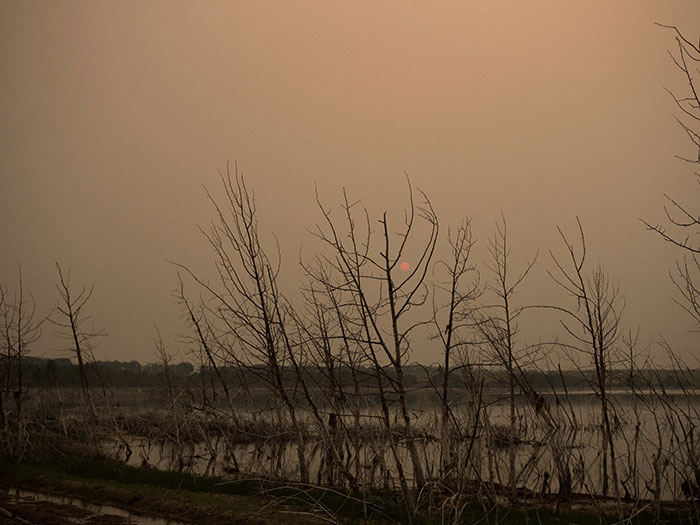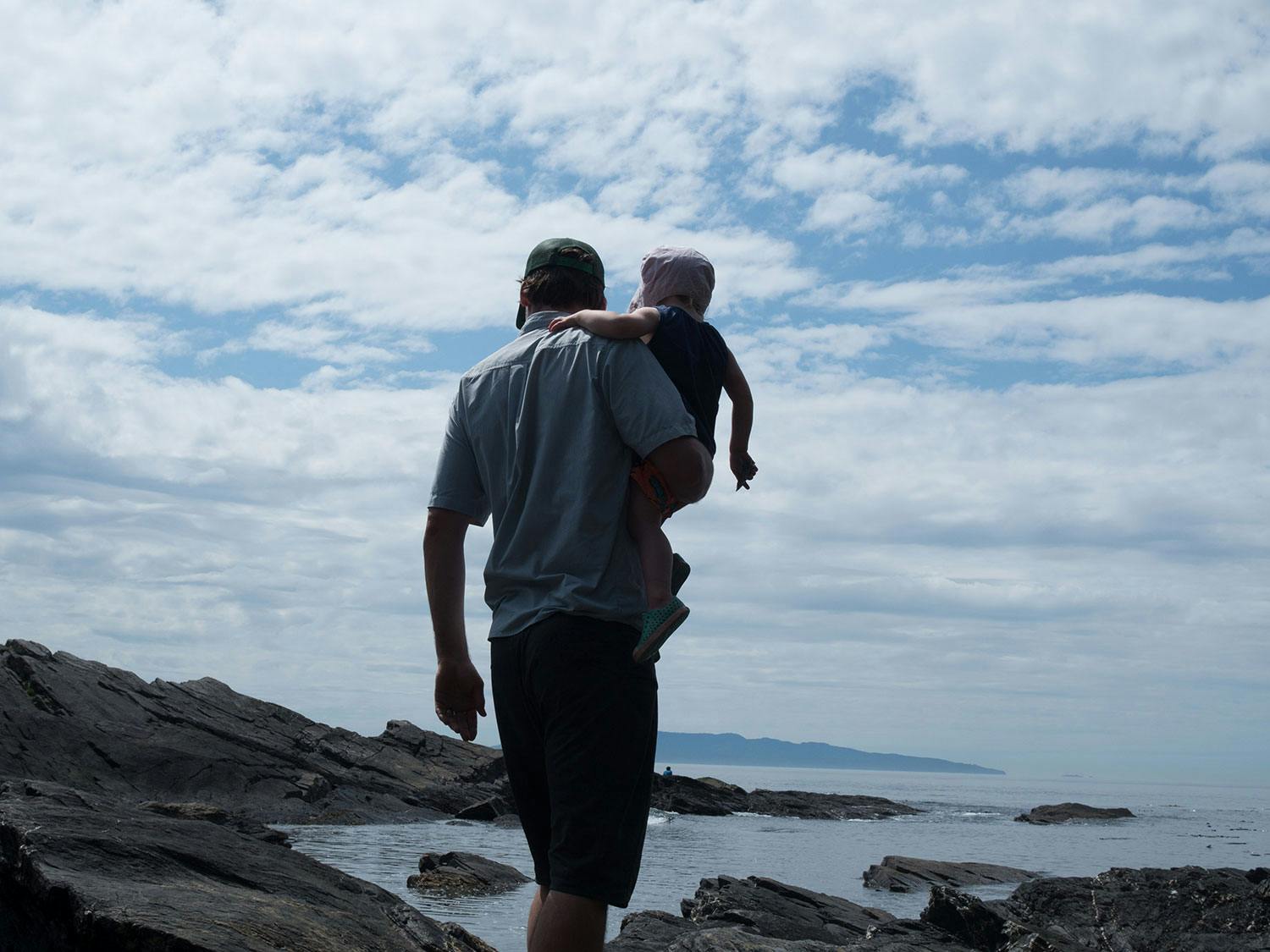Five Ways to Support our Kids through Climate Disasters
Whether the disaster’s on your doorstep or in the daily news, experts say parents can help kids cope.
The smoke came overnight, like a bad dream you try to rub from your eyes only to find it isn’t a dream at all. Although the Chuckegg Creek Fire burned over 1000 km away from our rural Alberta home, it turned our world an apocalyptic orange, made the air taste like soot, and kept us inside for the last days of May this year.
My toddler, Mini Ewe, was mainly grumpy about not being allowed to finger paint on our air purifier. But 4-year old Little Grey Lamb’s questions came fast and furious: When will the smoke stop? Will the wildfires come here? Why is this happening? Will Daddy have to go help? Can we fix it?
Parents like me aren’t phased by explaining where babies come from; we’re more concerned about explaining the climate crisis to a generation of kids caught between a game of hopscotch and a hurricane. Luckily, the experts have identified some best practices to help kids with their fears, without feeding them false promises.
Parents like me aren’t phased by explaining where babies come from; we’re more concerned about explaining the climate crisis.
1. Protecting our kids doesn’t mean withholding the truth.
As parents, we’re hardwired to protect our kids — but sometimes that instinct can lead us astray. While we might want to reduce our children’s anxiety by downplaying climate-related risks, research shows the most resilient kids have parents who are upfront and honest.
Caroline McDonald-Harker, professor of sociology at Mount Royal University, found that after the 2013 Alberta floods, some kids bounced back while others didn’t. By the time the 2016 Fort McMurray wildfires broke out, she was in the midst of a new study to identify the factors that contributed to that resiliency.
It turns out, the children whose parents engaged them in honest dialogue did better. For example, many of the kids whose parents tried to protect them by saying a disaster like the flood couldn’t happen again said they had less trust in their parents as they watched wildfires engulf Fort Mac.
“One of my strongest findings is that good communication helps children be resilient,” McDonald-Harker told me in an interview. “The one thing that I always recommend, regardless of age, is that parents are open and honest with their children.”
2. Taking action makes kids resilient.
While honesty is critical, McDonald-Harker says our kids should also be armed with age-appropriate knowledge around what to do in an emergency and how to act as “catalysts of change” in their communities.
Having a plan is critical for family safety, but it also reassures our kids. So next time Little Grey asks about whether the fires could come here, I’ll say, “I really hope they won’t, but I don’t know exactly what will happen in the future. You should know that we have a plan for emergencies. And here it is.” We followed the City of Calgary’s emergency guide to make our family plan, and love the city’s preparedness training courses, but there are no shortage of great resources out there.
Research shows the most resilient kids have parents who are upfront and honest.
McDonald-Harker also found that “the kids who talked about climate change and the ways that they actively engaged in environmental efforts were more resilient than the kids who did not.”
Many parents she interviewed said the disaster had no affect on their own or their children’s drive to act on climate change. But their kids said the exact opposite: youth from 5 to 17 years old listed actions they’d begun after the disaster that helped protect the planet, like biking or recycling. In this era of climate crisis, the kids are showing us they’re alright (even if their parents don’t know it).
I’ve worried that talking to my kids about climate action or making change in our community might be too much for them; knowing it creates feelings of control and empowerment is a tiny bit of good news in a bleak time.

Smoke from forest fires in other parts of Alberta has turned our air an apocalyptic orange a number of times in recent years.
3. Sometimes “I don’t know” is the wisest thing you could say.
Kent Hoffman — developmental researcher, co-creator of the Circle of Security parenting program, and author of Raising a Secure Child — told me that, “the bottom line of the bottom line is that children need to know they’re in the presence of someone who is bigger than them, stronger than them, wiser than them, and deeply, deeply kind.”
When Little Grey asked his questions, my instinct was to throw information at him. And some of that is necessary. But talking to Hoffman also reminded me what lies beyond our words: as the bigger, stronger, wiser, and kind grownups, our first job is to be calm and collected.
“The child needs to know that you’re reading between the lines,” says Hoffman. “The anxiety is really what is driving the question, and not the answer that you give them.”
When I don’t know if the fires will reach our home or if Daddy will have to go help, I need to be upfront with Little Grey. But I also need to remember that he’s looking for reassurance, which comes from both my words and my presence. By accessing both kindness and courage, I can say, “I don’t know. But I’m here with you. We have a plan, and we’ll work through this together.”
4. Be guided by stages, not ages.
I initially wanted this article to be an age-by-age guide to talking to kids about disasters, because the things we’re seeing seem to be so much more terrifying than I thought my 4-year-old could handle. But the climate crisis is transforming the nature of childhood. The world is intense, the future is uncertain, and there’s often no way to hide this from our kids.
The way we work through these events and conversations with kids makes a difference. My partner — a child and adolescent mental health therapist who’s worked with families post-disaster — points out that “traumatic events don’t always traumatize.” We can’t prevent all harm as parents, but the ways we support our kids can protect them from further harm.
While of course our conversations about disasters need to be as age-appropriate as possible, Mount Royal University’s McDonald-Harker suggests that “a better guideline than age is the stage your child is at.” Their questions will tell us what they’re ready to hear; following their lead, our answers should start general and move to specific when asked.
Their questions will tell us what they’re ready to hear.
If Little Grey asks whether the fires will come here, I can say, “I hear you’re worried. And while I don’t know what will happen exactly, I do know we’re prepared as a family.” If he follows up with another question about how we prepare, I answer, and just keep listening for what he really needs to know. As a parent herself, McDonald-Harker also knows some kids won’t ask questions, so we might just need to be the ones asking them questions, like “How do you feel about what we saw on the news?”
Close the conversation by asking if your child has any more questions, McDonald-Harker says; parents shouldn’t worry if they’re not clear on the answer. By saying, “I don’t know what causes these fires. Let’s look that up together,” we create a point of connection with our kids, and we increase trust. This also keeps our kids from seeking answers from friends with similarly incomplete knowledge, or from online sources that might scare or misinform them.
5. Tend to your own heart, too.
My quest to support my kids stems from loving them so much it hurts, but also from feeling like I’m on shaky ground myself these days. When I think unflinchingly about the answers to Little Grey’s questions — the bleakest parts I wouldn’t share with him right now — I feel like I’m staring into an abyss. The climate crisis terrifies me, but I need to stay grounded for my family.
Kent Hoffman is not your grandma’s parenting expert. He has a doctorate of theology and has worked with prisoners, homeless populations, and parents with traumatic pasts, so I have the feeling he knows my abyss well. “We’re at a time of huge peril in our culture,” he says, “partially because we have denuded reality from any sense of rootedness.”
Hoffman emphasizes that what he calls “communion” is necessary both for ourselves and our world. I’m not religious, but I have my own ways of connecting to the vastness within and without, some of which I’ve let slip since having kids. My personal practices are mindfulness meditation and moving through the wilderness, but everyone will have their own.
Anything that can tap us into the bigger picture is how we can access the support we need to support our children.
“Anything that can tap us into the bigger picture is how we can access the support we need to be able to support our children,” says Hoffman. “Otherwise we’re just trying to do it on our own — we’re just toughing it out.”
There’s no doubt that the world will be tough for Little Grey, Mini Ewe, and all the other small humans as they get bigger. Even though I experience a million moments of joy every day, if I stop too long, there’s also the white noise of worry in the background. (And by “worry” I mean dread). But Little Grey’s questions remind me that finding a purpose in this mess can be a powerful way to resist that dread. So today, my purpose is to be the bigger, wiser, stronger, and deeply kind grownup my kids need.
